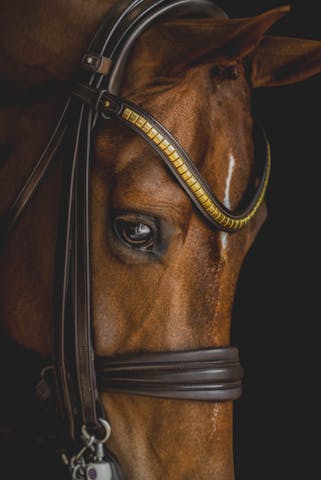
Bridle information
What is the purpose of bridle?
Bridles are a system of straps attached to the horse's head that are used to help the rider steer and stop the horse, usually in conjunction with a bit. The simplest bridle consists of a headstall or crownpiece that sits just behind the ears and attaches to cheekpieces that hold the bit in the horse's mouth.
Is bridle painful for horses?
Your horse's head, face, and mouth comprise sensitive nerves, bone, and soft tissue. While many of us focus on saddle fit, bridles and bits often get overlooked as a cause of discomfort. Bits can cause mouth pain and injury, and research shows many nosebands are adjusted too tight to the point of cruelty.
What is the noseband for on a bridle?
There are 2 functional reasons for nosebands on bridles: - To control the horse's mouth from opening. - To attach a standing martingale so you can control a horse's head from going too high.
What are the benefits of a noseband?
Nosebands do a few things, but the main purpose is to encourage bit contact by keeping the horse's mouth closed. This prevents him from putting a tongue over the bit, crossing his jaw, opening his mouth, or otherwise trying to evade the bit.
How does noseband work?
A drop noseband sits lower on the horse's nose and encircles the chin groove in front of the bit. This helps to reduce the horse from opening his mouth and crossing his jaw as pressure is applied low on the nose but once the horse relaxes the pressure stops and then has the same benefits of a cavesson noseband.
What is the history of the noseband?
Nosebands are one such piece of equipment used in many equestrian pursuits. Nosebands originated in the military due to their potential use as a head collar [1] and come in many traditional and contemporary designs. Today, they are commonly used to deter horses from opening their mouths and displacing their bit(s)

Browband information...
What does the Brow band do?
The brow band on a bridle helps keep the cheek pieces in the correct position without pinching around the base of the ears. The brow band also helps keep the bridle from slipping backwards on the horse's head.
How do you measure for a Brow band?
Measure from the end of each loop, straight across. Even if the style is curved. Standard browband loops are approximately 3cm wide. Headpiece: measured with the cheek pieces attached on the middle hole.
Where is the brow band on a horse?
Horse brow bands are part of the bridle, running across your horse's forehead just in front of the ears.
How tight should a brow band be?
A brow band should fit so that two fingers (stacked) fit comfortably under the front of the brow band. As we already mentioned, the throat latch should be unimpeded by the brow band, allowing it to hang vertically from the split. The throat latch helps to stabilise the bridle by preventing it from tipping side to side
What is the purpose of the reins on a bridle?
A bridle also includes reins and a bit. The reins consist of a long, narrow strap that attaches to the bit. Reins are held in a rider's hands and are used to guide a horse while riding. A bridle bit goes into the horse's mouth and is used with the reins to communicate with the horse.
How are the reins used?
Reins are used to give subtle commands or cues, also known as rein aids. Various commands may signal a turn, ask for a slower speed, request a halt or rein back. Rein aids are used along with leg aids, shifting of body weight, and sometimes voice commands.
what are Harness reins?
On some types of harnesses there might be supporting rings or "terrets" used to carry the reins over the animal's back. When pairs of equines are used in drawing a wagon or coach it is usual for the outer side of each pair to be connected to the reins and for the inside of the bits to be connected between the pair of horses by a short bridging strap or rope. The driver carries "four-in-hand" or "six-in-hand" being the number of reins connecting to the pairs.
Other uses...
A single rein or rope may be attached to a halter to lead or guide a horse or packhorse. A long rein called a longe line may be used to allow the horse to move in a circle for training purposes, or for the purpose of a clinical lameness evaluation by a veterinarian. On certain designs of headgear, a third rein may be added to the paired reins, used for leading, longing, or other specialised or stylistic purposes. The best-known example of a third rein used in the USA is the leading rein of the mecate of the classic bosal hackamore.

Reins Information...

Noseband/Cavesson formation



